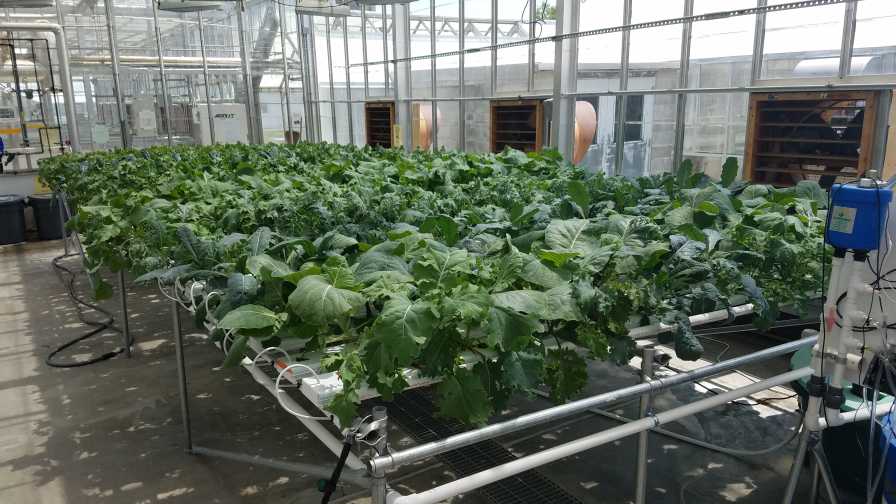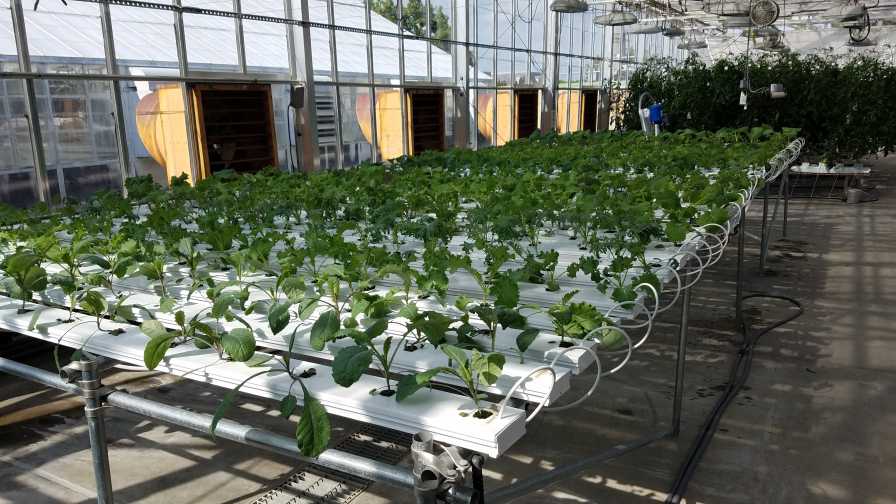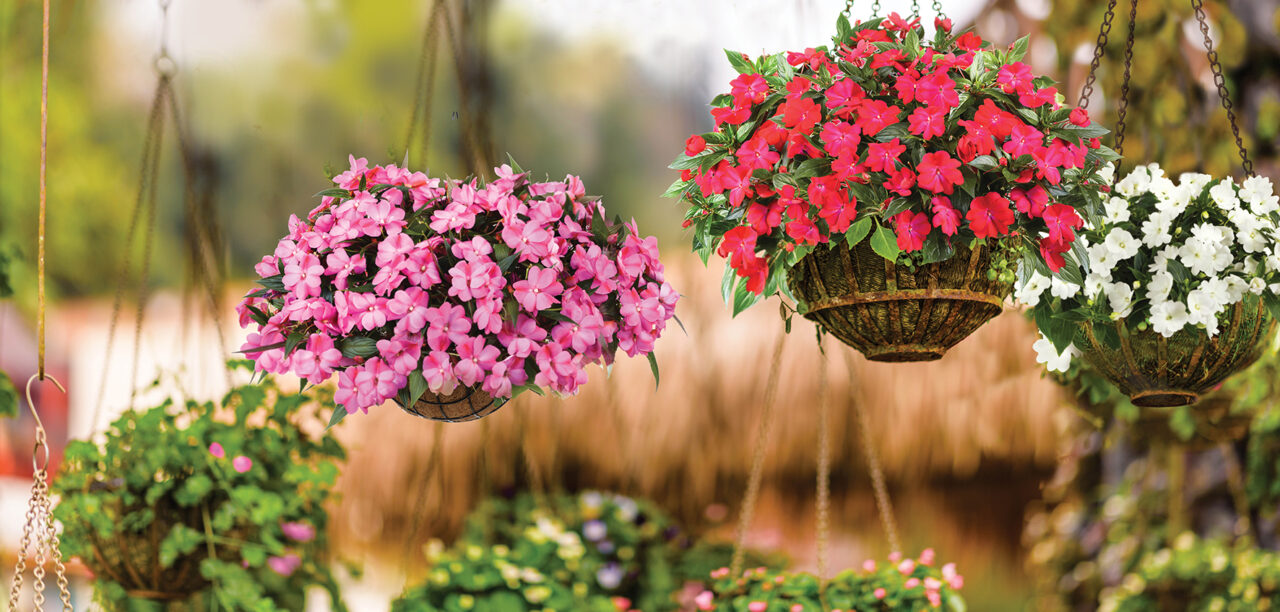5 Top Takeaways From Trial of Hydroponic Kale Cultivars

Researchers grew 14 kale cultivars for the trial. They harvested plants at two weeks for baby-leaf size and four weeks for harvest at juvenile size (pictured). Photo courtesy of Cornell University
Kale has seen a meteoric rise in popularity in the past decade as a versatile and nutritious leafy green. Consequently, kale has become an important crop for indoor vegetable growers. Kale can be grown to a traditional size in soil in hoop houses, to a juvenile size in nutrient film technique (NFT) hydroponic systems, or to a baby-leaf size in raft deep water culture (DWC) hydroponic systems in a greenhouse. No matter the size or the growing system, however, one difficulty with growing kale has always been cultivar selection.
Like lettuce, kale has several popular cultivars. But unlike its rival leafy green, little research has been done to compare the many kale cultivars available to growers in a hydroponic system. To help growers with their kale cultivar selection process, we conducted a study at Cornell University to compare the yields and phytonutrient contents (specifically carotenoids, important sources of antioxidants and compounds that support eye health) of 14 popular kale varieties.
Kale Cultivars Evaluated
The experiments were completed in the summer of 2019 in a climate-controlled greenhouse. The kale seeds were sown into a rockwool growing medium and grown for three weeks before being transplanted into an NFT hydroponic system. After transplant, the plants were grown for two weeks for harvest at baby-leaf size (five to seven true leaves, approximately 6-inch average leaf height) and four weeks for harvest at juvenile size (15 to 20 true leaves, approximately 20-inch average leaf height).
Attributes of the 14 Kale Cultivars
|
Cultivar |
Leaf Color |
Leaf Characteristics |
| Beira | Light green | Smooth, wide, cabbage-like leaves |
| Casper | Green | Curly, lobed leaves |
| Dazzling Blue | Green-blue | Smooth, waxy leaves |
| Dwarf Blue Curled | Green | Lacinato-type leaves |
| Fizz | Green-blue | Thin, highly serrated leaves |
| Premier | Green | Smooth leaves with serrated leaf edges |
| Red Chidori | Red | Curly, rosette-type kale |
| Red Russian | Red | Lobed, smooth leaves with purple veins |
| Red Ursa | Red | Smooth leaves with purple veins |
| Redbor | Purple | Highly curled, red-veined leaves |
| Scarlet | Purple | Curly, red-veined leaves |
| Toscano | Green-blue | Smooth, waxy, lacinato-type leaves |
| White Russian | Green | Red Russian-type leaves with light–green veins |
| Winterbor | Green | Highly curled leaves |
Here’s What We Learned
The results of this study led to the following five key takeaways:
1. Yields vary greatly between kale cultivars.
While the cultivars varied in shape, color, and texture, the most dramatic differences were seen in their yields. At both baby-leaf and juvenile size, there was a very wide range of fresh weights between the 14 varieties. The highest-yielding varieties at juvenile size were ‘Premier’ (468 grams per plant, or g/plant) and ‘Beira’ (367 g/plant), which yielded more than three times as much as the lowest performing varieties ‘Scarlet’ (118 g/plant) and ‘Red Chidori’ (115 g/plant). The drastic differences in yield between the kale varieties show just how important cultivar selection is for kale growers. However, beyond yield, different kale types have different uses and flavors, so it’s extremely important for growers to understand which types of kale their customers prefer.
2. Carotenoid concentrations vary greatly between kale cultivars.
Two carotenoids found in high concentrations in kale, lutein and violaxanthin, were extracted and quantified from each of the kale varieties. Kale is an excellent source of carotenoids; however, not all kale varieties have the same levels of these important phytonutrients. The study found that the total carotenoid concentrations of the cultivars ranged from 12 to 27 mg/100 g and that the cultivars ‘Toscano’ and ‘Dazzling Blue’ had the highest concentrations of both lutein and violaxanthin. By selecting cultivars such as these with high concentrations of carotenoids, growers can be confident that they are growing the most nutritious kale for their customers.
3. The highest-yielding kale cultivars are not necessarily the most nutritious.
The two highest-yielding cultivars, ‘Premier’ and ‘Beira’, had below-average carotenoid concentrations. Additionally, the cultivars with the highest carotenoid concentrations, ‘Toscano’ and ‘Dazzling Blue’, yielded far less than many of the other varieties. This shows there is not one perfect kale variety in terms of yield and phytonutrient content and that growers must decide which is most important to them and their customers.
4. Dark green-blue colored kale may be more nutritious.
The 14 varieties varied greatly in color — ranging from purple to light green to dark green-blue. Interestingly, the two varieties that had the darkest green-blue color, ‘Toscano’ and ‘Dazzling Blue’, had the highest carotenoid concentrations. These two varieties also had the highest chlorophyll concentrations. More research is needed to verify this finding with other cultivars, but it may be that growers who hope to provide their customers with the most nutritious varieties may simply be able to compare varieties based on their color.

Ten out of 14 varieties of the baby-leaf sized kale (pictured) in the cultivar trial had a higher carotenoid concentration than the juvenile-sized kale.
Photo courtesy of Cornell University
5. Baby-leaf kale may be more nutritious than juvenile kale.
Carotenoid concentrations were quantified for each of the varieties at both baby-leaf size and juvenile size. Interestingly, for 10 out of 14 varieties, the baby-leaf sized kale had a higher carotenoid concentration than the juvenile-sized kale. For example, the cultivar ‘Toscano’ had a total carotenoid concentration of 26 mg/100 g at juvenile size and 31 mg/100 g at baby-leaf size. Although for most of the varieties the differences were not huge, it is interesting to consider that baby-leaf vegetables may have additional nutritional benefits compared to larger-sized plants.
Overall, this study highlights the great variation in yield and phytonutrient content between the numerous popular kale varieties. We hope these findings will be helpful to controlled-environment agriculture growers in their kale cultivar selection process.
Acknowledgements: Funding for this project was provided by the National Science Foundation under award number 1739163. The authors thank Marianne Nyman and Eyosias Ashenafi at Rensselaer Polytechnic Institute for conducting the carotenoid analysis.









